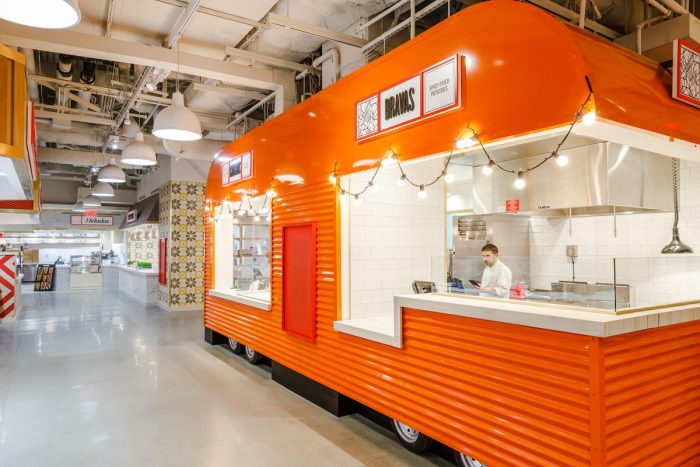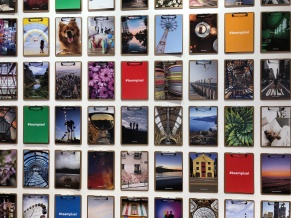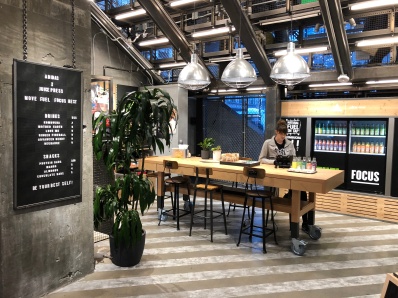Leon Medical Centers
Rutgers Nursing and Science Building
Drexel University College of Nursing
FRCH NELSON Reveals New Identity To Align With The Future Of Retail
Minneapolis, MN — September 30, 2020 — FRCH NELSON, a global brand experience firm delivering strategy, design, and architecture services for the retail industry, is now NELSON Worldwide—a multifaceted brand helping to create and deliver compelling retail experiences across the globe. The rebrand will serve to culturally connect and unite all brands under a single banner and provide clients with a holistic approach to design that is unrivaled in the industry.
“Today’s consumers are engaging with brands in a much more fluid manner, moving through experiences with no delineation in mind about format, location, or category,” says Robyn Novak, Vice President at FRCH NELSON. “This exciting transition will provide us with ample resources to continue to transform environments where people shop, dine, and play.”
FRCH NELSON has been creating innovative brand experiences for consumer-facing environments for over 50 years and has an impressive roster of clients including Macy’s, Saks Fifth Avenue, Tiffany & Co., Hershey’s, Kroger, Target, T-Mobile, Dick’s Sporting Goods, American Girl, Subway, YUM! Brands, and more. Officially merged in 2018, both NELSON and FRCH NELSON (formerly FRCH Design Worldwide) have forged a strong partnership that allowed them to holistically serve a diverse client base consisting of both long-standing relationships with Fortune 500 category leaders in multiple market segments, as well as boutique clients.
The universal identity, coupled with the firm’s dedication to design excellence, will allow for the free-flowing exchange of new ideas to deliver projects that boldly achieve client goals and uplift their surroundings. The traditional sectors of retail, hospitality, workplace, industrial, and even healthcare have blurred—and their influence signifies a shift in function and utilization of spaces. Consumer behaviors and preferences will continue to evolve, and this transition to one NELSON brand will provide clients with an unmatched, holistic approach.
“One-use destinations of the past have now become a mosaic of activities and engagement, a reflection of wavering consumer preferences and a desire to unify experiences. This rebrand demonstrates our continued commitment to bring more value to our clients. We look forward to continuing to build upon trusted partnerships as well as forging new ones along the way,” said Chairman and Chief Executive Officer of NELSON Worldwide, John “Ozzie” Nelson Jr.
Under the NELSON Worldwide name, the firm comes together with more than 1,100 teammates spread across 25 offices, combining decades of invaluable industry experience, service expertise, and geographic reach to deliver projects—not just across the country, but around the world. As the firm continues to strengthen its practices, one thing remains clear: NELSON is committed to innovative, boundary-pushing designs that transform and touch all dimensions of the human experience while seeking to learn, grow, and experiment through architecture and design to fuel the future.
About NELSON Worldwide
NELSON Worldwide is an award-winning firm delivering architecture, interior design, graphic design, and brand strategy services that transform all dimensions of the human experience, providing our clients with strategic and creative solutions that positively impact their lives and the environments where they work, serve, play, and thrive. Our collective network includes more than 1,100 teammates in 25 offices, combining industry experience, service expertise, and geographic reach to deliver projects across the country and around the world. Client partnerships across the NELSON network include: Hilton, Macy’s, Comcast, Simon Property Group, Prologis, Yum! Brands, Boston Consulting Group, T-Mobile, Emory Healthcare, SAP Fieldglass, Unibail-Rodamco-Westfield, Kroger, Hyatt, Bayer, Target, and many more.
Media Contact:
Caroline Saba
Associate Vice President
UpSpring PR
T: 646.722.8146
E: caroline@upspringpr.com
Leveraging Technology to Attract and Retain
Advancements in technology have been improving workplace productivity for years, allowing us to work virtually from anywhere. Now that a global pandemic is forcing us to work from home, the question being posed seems to be, why return to the office at all? According our “Evolving Workforce Expectations” study, only 7% of employees want to return to work a full five days a week. If employees are a company’s most valuable asset, employers must make the workplace a sought-after destination for everyone, one that people are excited to return to.
Brands will need to reevaluate their office portfolio and determine a plan to ensure their employees can take advantage of new technologies that make communicating, collaborating, and connecting, more seamless than ever before.
But while technology continues to rapidly evolve to better bridge the gap between physical and virtual workers, the most critical element for successful adoption and activation of these tools will be a robust change management strategy. Employers must provide holistic awareness, training, and buy-in to effectively activate these new, digitally focused offerings.
Here are the four ways technology can be used to make the workplace a sought-after destination:
Instant communication
Brands are having to communicate with their employees more than ever before, and because so many things are constantly evolving, the need for immediate communication is imperative.
Integrated workplace management systems like iOffice and their employee experience app Hummingbird, previously considered luxuries, will be necessities. With technology like this, employees can reserve workstations or conference rooms, submit service requests, be alerted to incoming mail, visitors, and more, all from their own mobile devices. Employers can also keep a close eye on who is in and out of their facility each day, constantly monitoring capacity to keep their employees safe.
As wearable technology gains more popularity, many employers are realizing these tools offer a unique opportunity to communicate with employees. With the traditional, in-office nine to five likely becoming extinct, a singular means of communication like email won’t be enough. And with employees working from a variety of environments including coffee shops, home offices, hotel lounges, and even their cars, wearable technology is something they’ll always have access to.
As the mobile workforce and risks of cyber security attacks continue to increase, innovative solutions like Samsung Knox are changing the way companies use wearables, embedding their software within workers’ mobile devices and smartwatches to secure company data, and help mitigate breaches of private company information.
Real-time collaboration
Collaboration tools will only gain more popularity during and after the pandemic. From video conferencing, to file sharing, there are numerous tools that will make the hybrid work day more seamless. It is no longer just about meeting virtually anymore, it is about going a step further to integrate with multiple platforms, support blended teams, provide robust collaboration opportunities, and the ability to accommodate smaller, breakout groups virtually.
Even before the pandemic tech giants like Microsoft were perfecting their cloud-based collaboration tools, but the social distancing, work-from-home mandates are accelerating this trend. These brands have taken a close look at how consumers have had to change their behaviors drastically in a short period of time and made improvements to their tools to make the digital experience as close as possible to the real-time experience.
Today, digital meeting facilitators can set up automated emails connected to their meetings, making it easier to manage attendance. They can also view a dashboard after to get a big picture report of attendee engagement. Video webinars can be recorded and later shared with the group along with a full transcript, file attachments, and any discussions from the chat window of a video or call. From custom backdrops, and screen sharing, to virtual chalkboards and collaborative documents, there isn’t much you can’t do remote anymore, making tools like these imperative when returning to the physical office.
Other tools such as Slack and Microsoft Teams reduce the amount of emails needed in a work day, by offering one, cohesive platform for teams to communicate. Mural is another online tool for ideation sessions, providing a more visual-based platform to facilitate blue-sky thinking.
Connection without distraction
Video conferencing technologies like Zoom are here to stay. Especially since many white-collar corporations are extending the work-from-home period until as late as next summer. This means many workers will need a hybrid environment to connect with clients, colleagues, and business partners. Many will still want their own desk space to retreat to for heads down work, but the popular open concept environments aren’t conducive for lengthy zoom meetings or other new-age virtual tasks.
Rethinking conference rooms of all sizes is one way to accommodate these new hybrid environments. Because guests, clients, and other visitors from outside of an organization are less likely to go into an office that isn’t theirs, large conference rooms, both within the tenant space, and the shared building, sit empty and unused.
These underutilized meeting rooms can be transformed to a few different types of meeting areas:
- Production Pod – For one-on-one video conferencing meetings, a place where employees can go to chat with their colleague who may be working from home, or their client who may not be comfortable coming into the office. Although there isn’t much square footage needed, the room must be sound proof, and equipped with all the AV technology needed to perform a seamless video call, including a large monitor with easy connection to a laptop, a power source, and good lighting for video visibility.
- Collaboration Suite – A little bigger and can accommodate a larger group. This room comes with everything the smaller production pod includes, but with an even bigger monitor with an auto-framing video camera to track and focus on who in the room is speaking and stacked theater seating for visibility. Creating a physical destination that puts blended teams on equal footing.
- Presentation Studio – A production room equipped with podcast equipment, a green screen, advanced sound and recording tools, will be beneficial for employees creating more elevated, digital content that will continue to remain the norm, years after the pandemic.
Essential safety
Revolutionary technologies are improving quality of life for millions of Americans living through this global pandemic. Telehealth services are increasing in popularity due to COVID-19, offering a safe way for patients to stay out of overwhelmed healthcare systems and prevent the risk of exposure. Smartphone and wearable technology tracking has even been used to trace contact of those infected with the virus.
When employees return to work, these types of technologies can make a huge difference. Employers and landlords can start small with zero-touch adjustments like automated doors and motion sensor lighting. Steelcase’s RoomWizard is a completely hands-free solution for meeting room reservations. Employees simply walk into an available room and begin working and the smart technology marks the room in-use.
Larger investments include innovative technologies such as body temperature walk-through kiosks, germicidal UV light, and more. Investing in technologies that make employees feel safe can go a long way and hold significant value.
In the end, the key to success when returning to work will be change management. Think about how quickly we’ve all adjusted to day-to-day routines like working from home, going to the grocery store, and dining out at restaurants. Wearing masks, temperature checks, and social distancing were once foreign behaviors none of us ever had to practice, a few short months later, it seems normal. Managing expectations and offering the tools and environment needed to communicate, connect, collaborate, and stay safe will set employees up for success and get them excited to return to the new workplace destination.
Sustainability Explained: 7 Things You Need To Know
Building and designing sustainable spaces has always been important, but as we become a self-aware society, driving sustainability by way of green building practices far exceeds the boundaries of the building envelope. For the design industry, sustainability considers the project space, surrounding communities from which we source materials, and the eco-system that operates within an environment. In recent years, sustainability has become more than just a “good practice” but a way for organizations to differentiate themselves and make a positive impact on the world.
At NELSON Worldwide, we understand that architecture and design have a unique ability, and responsibility to promote environmental stewardship. Keep reading to better understand key themes we see in the sustainable solutions of today – and the future:
1. WELLbeing
Due to the ever-growing need for sustainable solutions, architects and designers are pursuing certifications in LEED and WELL. While both have been around for quite some time, no sustainability list is complete without mentioning these table stakes. For the workplace, WELL design is one of the fastest-growing certifications and is built and optimized to advance human health and well-being. Taking every interaction an individual can have within a space into consideration, this certification covers 10 core concepts of design considerations related to health and hundreds of standards that revolutionize the design approach. At NELSON Worldwide offices in Philadelphia, the guiding principles of WELL dictated low emitting finishes and furniture and diverse spaces the promote collaboration or support employee rest, yoga, meditation or simply a space to unwind.
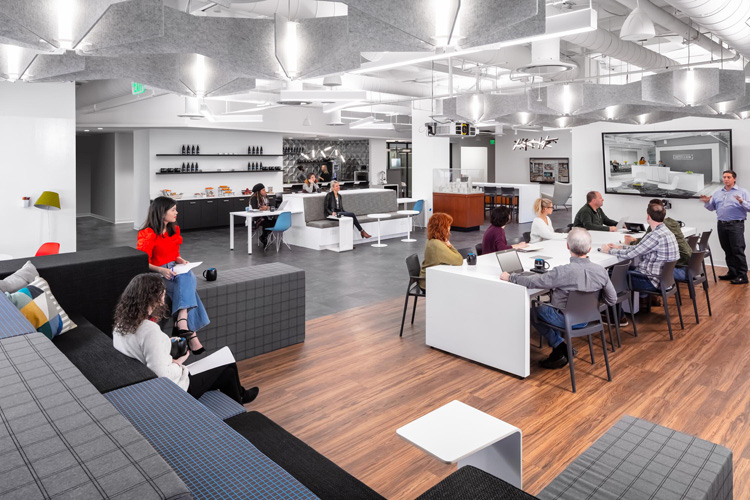
2. Natural Moments
Born from the years of bringing ‘the outdoors in’, the design industry is largely promoting biophilic design. While this does include the infamous living wall, the strategy goes much deeper to include any relationship a space can have with nature. Further, bringing living natural elements within promotes wellness through cleaning the air we breathe of particulates, reducing asthmatic responses, and increasing oxygen levels. The aesthetics of biophilic design also promotes mental wellness. From an outdoor patio to a table made from a tree trunk, there are many ways that biophilic design can be adopted. In many of today’s environments, you may notice patterns, finishes, textures, materials, and even lighting that are derived from or mimic nature. Combined, these elements promote eco-friendly, health-conscious elements that foster a more sustainable lifestyle. At Burwood Brickworks, a mixed-use development that will open by the end of 2019 in Australia, the core design philosophy focuses on a database of natural materials that are used in concepts like a rooftop farm and greenhouse cafes.
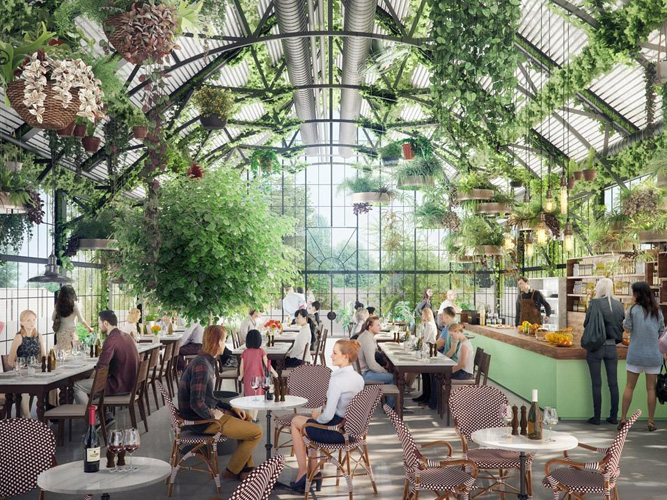

3. Biomimicracy
Similar but different to biophilic design, biomimicry is a concept that is inspired by the processes of nature that are around us every day and have been around since the beginning of time. In official terms, biomimicry refers to the design of products and materials that draw solutions from nature to enhance structural efficiency, energy supply, and more. Think about the natural insulation found inside cacti or a building inspired by the work of termites. As nature acts as a natural form of architecture, man-made buildings should be able to mimic these successful strategies.
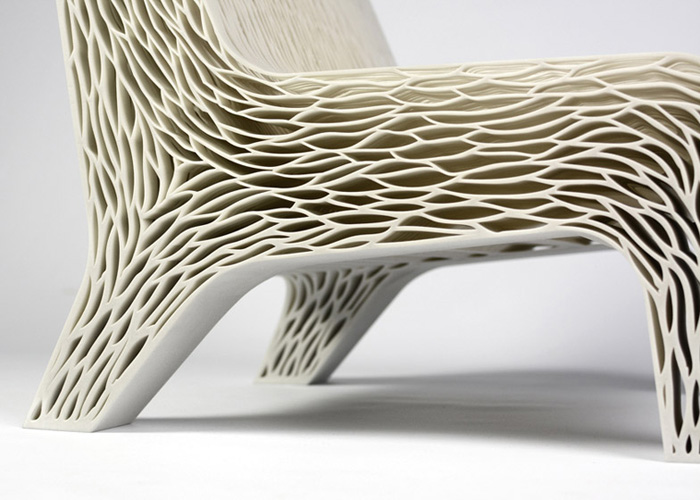
4. Becoming A Circular Economy
According to the Ellen Macarthur Foundation, a circular economy is one that is focused on growth and positive society-wide benefits. This concept most popularly includes decreasing the consumption of finite resources and eliminating waste. In three simple points, this includes:
-
- Designing out waste and pollution
- Keeping products and materials in use
- Regenerating natural systems
Researchers, architects, and designers from around the globe are teaming up to create basic building materials out of waste materials. In the UK, material consults at Local Works Studio have created a line of wall tiles made out of discarded oysters while coffee mogul, Starbucks, has started to use building bricks made of construction/demolition waste made by Dutch supplier Stonecylcing.

5. Smart Office
Although technology isn’t new to the workplace, embracing advanced technology like artificial intelligence and facility management systems can make a space more sustainable. Offices with smart technology can optimize and control the usage of electricity and water, and monitor air quality. Smart technology can also cut confusion that may come with scheduling and communication tasks, to create a smooth and stress-free workflow. iOFFICE, one of the largest facility management and IWMS softwares on the market, has partnered with various organizations to provide office tech that capture metrics on a space’s energy use all the way down to an individual device.
6. Pre-fabricated Design
Environmentally conscious designers and architects are pioneering a variety of solutions in prefabricated or modular building elements to cut carbon footprint and construction times; traditional builds yield a variety of waste and air quality concerns associated with drywall and finishes and often take a lot of time to complete. These solutions have also proven to be more flexible making it easier to adjust to changes in light, ventilation, foot traffic, and even location. For example, Flying Nest a revolutionary hotel concept by French designer Ora-ito, is a modular structure that can move anywhere in the world. The hotel is currently being used by event organizers, festivals, and exhibits so that new builds are not needed for mobile groups/organizations.
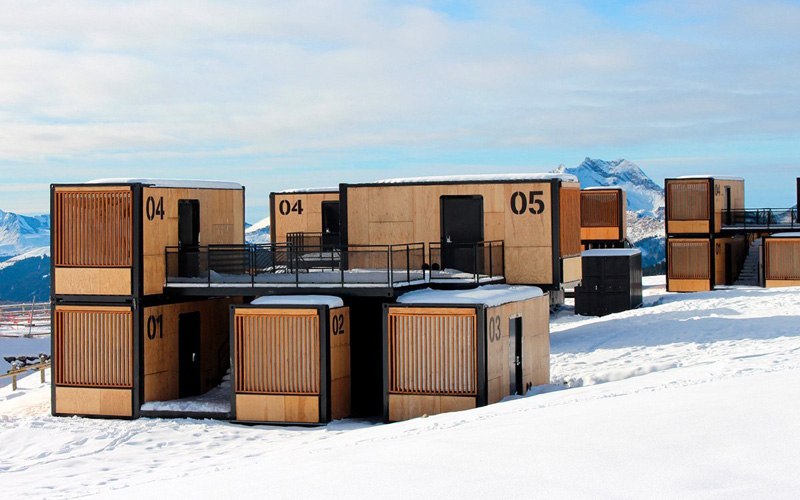
7. Resilient Design
According to the Resilient Design Institue, resilient design is the intentional design of buildings, landscapes, communities, and regions in response to its vulnerabilities. Relative to climate change, resilience involves adaptation to the wide range of regional and localized impacts that are expected with a warming planet. Using these strategies helps us to create buildings that last longer, and in turn, keep us from using valuable resources needed for new builds. In 2017, the Fishermens Community Hospital located in the Florida Keys was wiped out by Hurricane Irma. Today, NELSON Worldwide is using resilient design to rebuild the facility so that is can withstand even stronger tropical storms in the future.
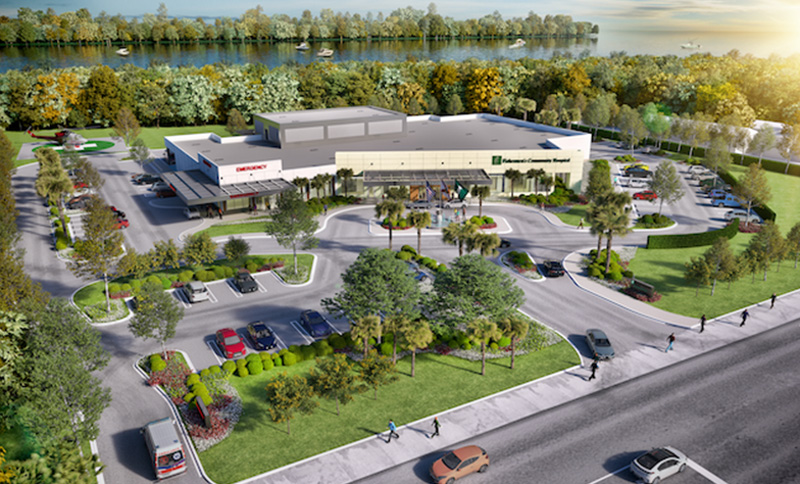
Anila Quayyum Agha
The FRCH NELSON Creative Culture Committee took some lucky FRCH-ers on a field trip last week to the Cincinnati Art Museum to experience the art of Pakistani-American artist Anila Quayyum Agha. The exhibit entitled, All the Flowers Are for Me (Red), was created using laser-cut steel and light. Light emanates from the red lacquered cube, enveloping the gallery in intricate shadows that ripple and change as visitors move through the space. A few FRCH-ers share their reactions to the stunning display:
“I was surrounded by only light and shadow…It was one of most magnificent installation that can calm the agitations of our soul.” ~ Heesun Kim
“For something so out of its element, amazed how the exhibition seemed to fit the space so perfectly; simply poetic. Wonder if this is how the others viewed the artist considering her description of the two different worlds she felt she was living in.” ~ Elizabeth Birkenhauer
“A stunning display of light and shadow. It created a completely immersive yet out of this world experience.” ~ Allison Schmid
“Light lands on all surfaces, reflecting what it’s gone through.” ~ Lawrence Song
“The object floated weightlessly in the air, casting a mesmerizing effect onto every surface.The guests became entwined with the art. Light and shadow danced across each passerby, the intricacies manipulated differently onto each form.” ~ Liz Baverman
If you have not already, we highly recommend checking out this uniquely beautiful exhibit. The exhibition is free to the public and runs until October 15th.

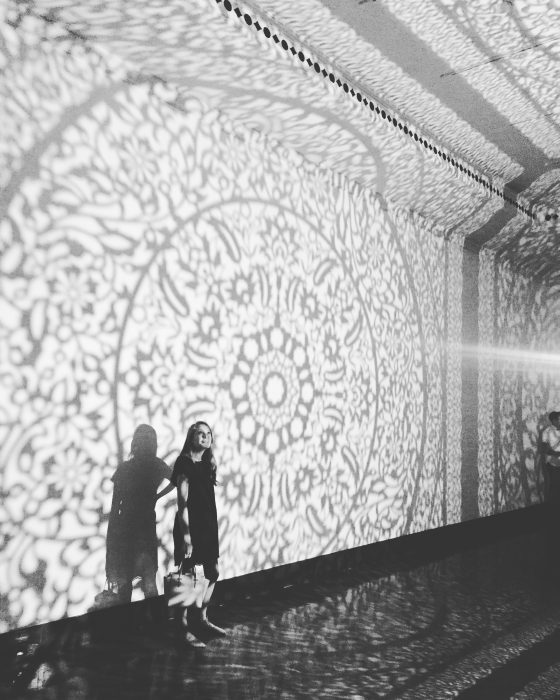
Teammate Travels: Amsterdam In A Blur
Recently, I had an opportunity to take in Amsterdam, a city that has somehow eluded me in my travels. Free time was limited so my exploration was fast and furious. It would have been tragic if I were to have made my way back home without gleaning something meaningful in the form of inspiration. I had long heard the stories and the tourist-y trappings of what makes the city world-famous, but I remained determined to sneak in an opportunity to develop an enlightened perspective on the city, it’s culture and of course, it’s design.
Peep the slideshows for a blurred peek at some of what inspired me along the way. Highlights include simply walking the neighborhoods avoiding bicycles, soaking in the charm of the cities many canals, deciphering the quirky architecture, foraging into hotels for hospitality and sustenance, dipping into record shops, a trip to the MOCO for a street art exhibit, a random neighborhood art fair/ street festival, window shopping antiques, and a long-anticipated peruse through the Droog experience. I can’t wait to get back!
Architecture + Design
Art
Retail
Food
“Experience” NYC Retail
I had the (rare) fortune last week of having a few moments to check out some of the latest retail concepts in New York. And knowing in the back of my mind that “experience” might be the most overused word in retail in 2017, I went in expecting to “experience something” and let’s just say NYC retail didn’t let me down. Whether it be interactive, personalized or just over the top grandeur in flagship scale, there was plenty to check out and really dive deep into some of the brand stories. Some of my favorites included:
The new Google experience was pure delight — letting all of us feel like “we were kids again”. Playing with “big kid toys” via the VR goggles, the AR merchandising presentations, and even the Stranger Things Photo Experience and “Photo Booth” brought pure play into the shopping experience (and all executed fairly simply). The associates did a phenomenal job continuously highlighting the features and benefits of the products that were delivering the “experiences”. Thanks Google for offering a moment of respite on a cold fall day — for a second we forgot we were shopping!
American Eagle
Unbeknownst to us we arrived on opening day! Two things made this an exceptional experience: 1. The associates. They could not have been more proud of the store and were happy to show it off and 2. The open platform for the store mixing retail, customization and dwell time into a cohesive space that felt part retail, part atelier, part studio space and part hip hangout. We were impressed with AE‘s customization offering; it initially appeared like minor accessories could be added to your denim wear, but apparently their associates have already pulled off some pretty impressive, custom denim looks for customers. As well we were drawn to the real estate dedicated to supporting customers – offering free laundry for local college students as well as a cooperative work space and lounge.
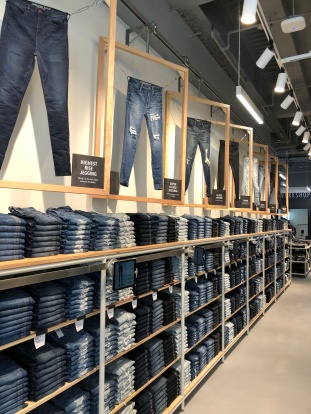
Adidas 5th Avenue Flagship
I always love it when brands go big and go bold. The Adidas Flagship on 5th Avenue does just that, creating a customer journey that intertwines a voluminous environment with a mix of personal spaces, customized experiences, retail vignettes and educational platforms. While the product is truly hero presented via dynamic visual merchandising stories, it’s the unexpected moments at every turn that really bring this brand experience to life. Whether it be the testing area for product trial, the print shop for personalization, the customized shoe shop offering curated opportunities or the juice bar (yes, even refreshments have been incorporated to align with the brand) there are experiences for every athlete.
Perfect for the holidays, YSL created a simple, yet well-choreographed experience for its SoHo pop-up. Highlighting both fragrance and cosmetics, the store brought trial to the forefront. Having their national style artist there was the perfect start for one-on-one consultations, but the brand married that with a “virtual trial” system that was flawless in updating selections in the moment. And to top it off you could fully customize your product case via in-store engraving in only a matter of seconds with the design of your choice.
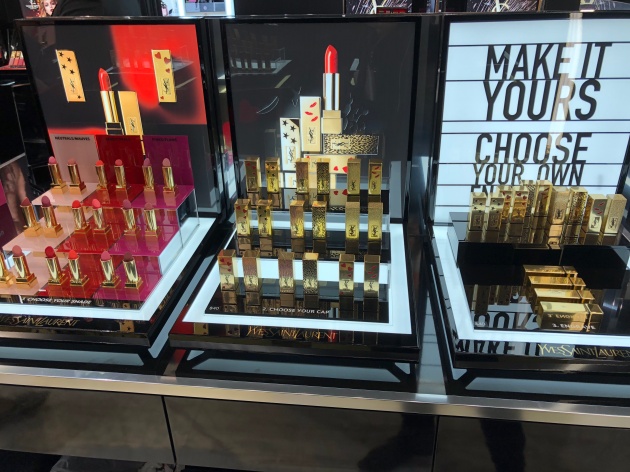
NYC Fluid Retail: Restaurant Edition
New York Market Week and NYCxDESIGN are fast approaching and as retail continues to rapidly transform, we’re looking beyond the immediate industry, to environments and concepts inspiring the retail of tomorrow. Today’s consumers engage with brands in a fluid manner, the traditional sectors of the retail, restaurant, hospitality, and entertainment have blurred as the consumer-desired experience has become a mosaic of expectations, influenced heavily by engagement, access, and authenticity. Embracing these new expectations presents brands with a greater opportunity to differentiate, cross-sell and expand the breadth of their brand experience. So, this year while in the city we’ll be exploring some of the city’s most innovative new concepts across multiple industries, that we think could be a driving force in the retail experience of the future.
This first segment will focus on Food + Beverage concepts, with more markets showcased in the coming weeks. Below you will find the best spots in and around NYC to experience food – whether it’s a market hall, grocery pop-up, or mobile supper club.
Resident | Mobile Supper Club
New York’s newest buzzy supper club popping up in secret locations in Williamsburg, Brooklyn. Acting as a culinary incubator pop-up, chefs and dinner guests and chefs get the chance to host one another to enjoy a meal and share stories.
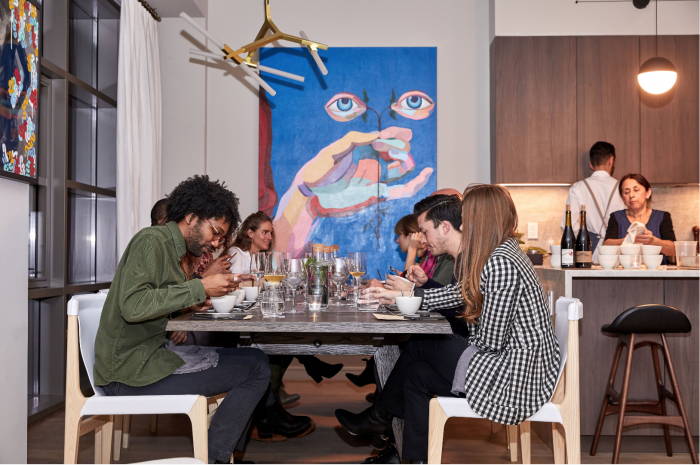
Hungry Root | Flatiron District Pop-Up
This e-commerce grocer debuted it’s first ever IRL pop-up this spring in the Flatiron district. At the space, one can find individual items the brand provides online. The store is as bright and charming as the brand and you’re sure to find something to snack on if you stop by.
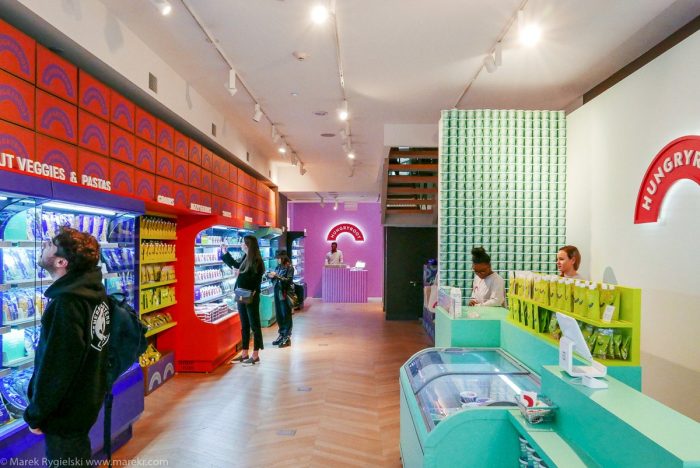
Market Line at Essex Crossing (Opening May13th) | Lower East Side Food Hall
The highly anticipated move of Essex Street Market has come and many of its legacy vendors are going with it. Previously known as NYC’s oldest public market, the move to Essex Crossing will make room for even more food vendors and businesses alike. In addition to plenty of food stops, ESM will also have retail, office, and apartment spaces. New to the market’s concept will be the Market Line, a developer-owned food hall that will be located on the lower level.
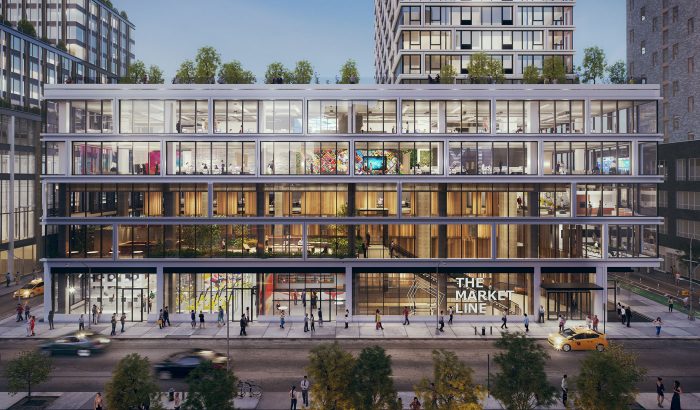
Mint Kitchen | Union Square Fast Casual
Mint Kitchen focuses on fresh Israeli dishes and snacks as a fast-casual concept. The 50-seat space is bright and open, finished with light wood and lots of greenery. A traditional taboon oven anchors an open kitchen decorated with emerald-colored tiling allowing customers to see the chefs in action.

Gertie | Williamsburg Luncheonette With A Twist
Paying homage to an iconic grandmother, Gertie located in Williamsburg is a newly opened “luncheonette” serving old-school deli counter offerings with a 2019 twist. Here, silverware is presented in mason jars and vintage jars and a colorful mural compliments the naturally lit, 70s motif themed spot.
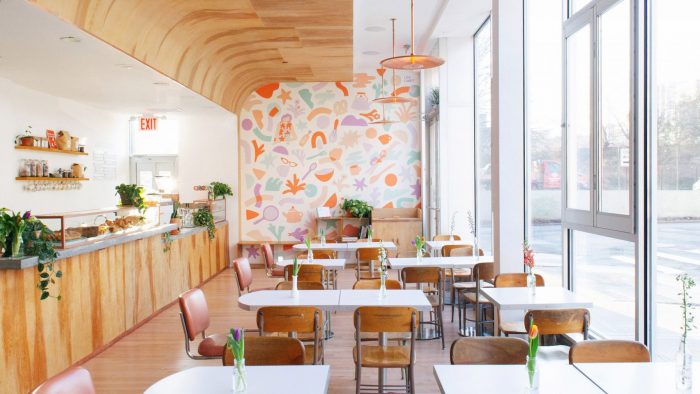
GupShup | Gramercy Hot Spot
The modern Indian theme trend has spread wide across NYC and GupShup located in Gramercy is rocking it in full force dishing 70’s Bombay vibes. In addition to tasting fusion heavy dishes, visitors can enjoy live music while surrounded by shiny décor, bold murals, and grand chandeliers.
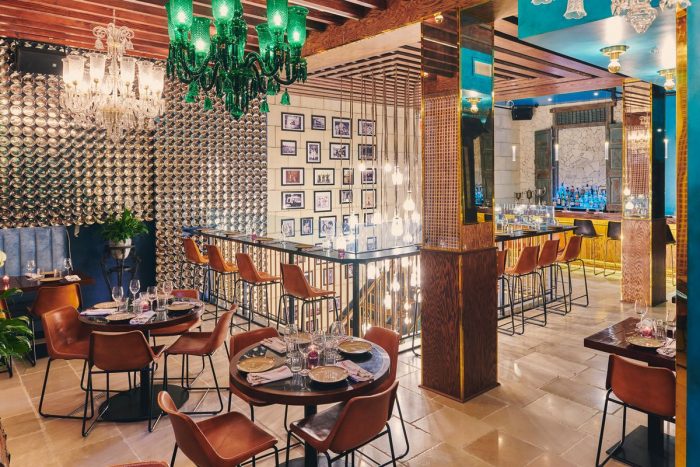
Junzi Kitchen | Manhattan Ambitious Fast Casual
Called the ”Chinese SweetGreen” Junzi is a fast-casual concept serving up Asian dishes that you may have never heard of. The company hopes to open 15-20 more locations in Manhattan in the next 3 years and hopes to transform the mainstream American perception of Asian cuisine.
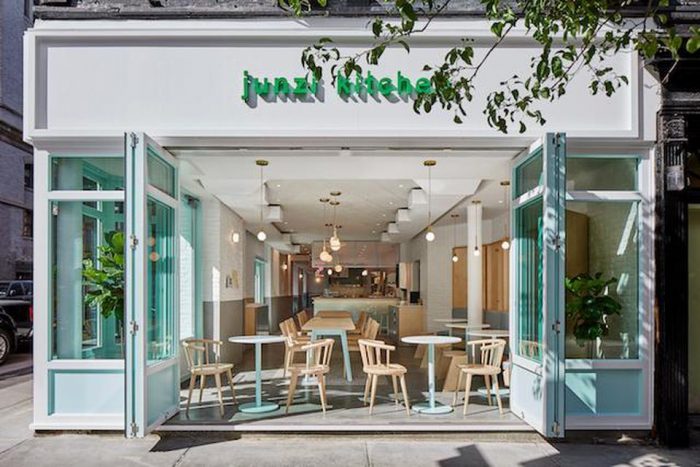
Mission Chinese Food Brooklyn | Buschwick Hot Spot
Featuring a stark concrete interior lit by LED tubes, MCF in Bushwick is nothing short of what you’d expect from this celebrity chef-owned restaurant. Inside you not only get to experience a unique style of cooking but an array of interesting short films produced by the restaurant’s design team.
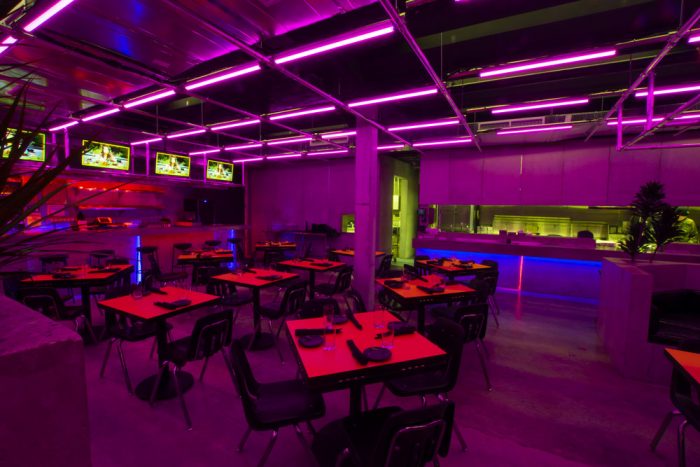
Mercado Little Spain | Hudson Yards Food Hall
This newly opened (and still in progress) food located at Hudson Yards aims to showcase all that Spain’s culinary scene has to offer. The 35,000 SF space has three full-service restaurants, plenty of space for tapas, wine, and coffee, retail space for a flower and dry goods shop, and over a dozen vendor stalls.
